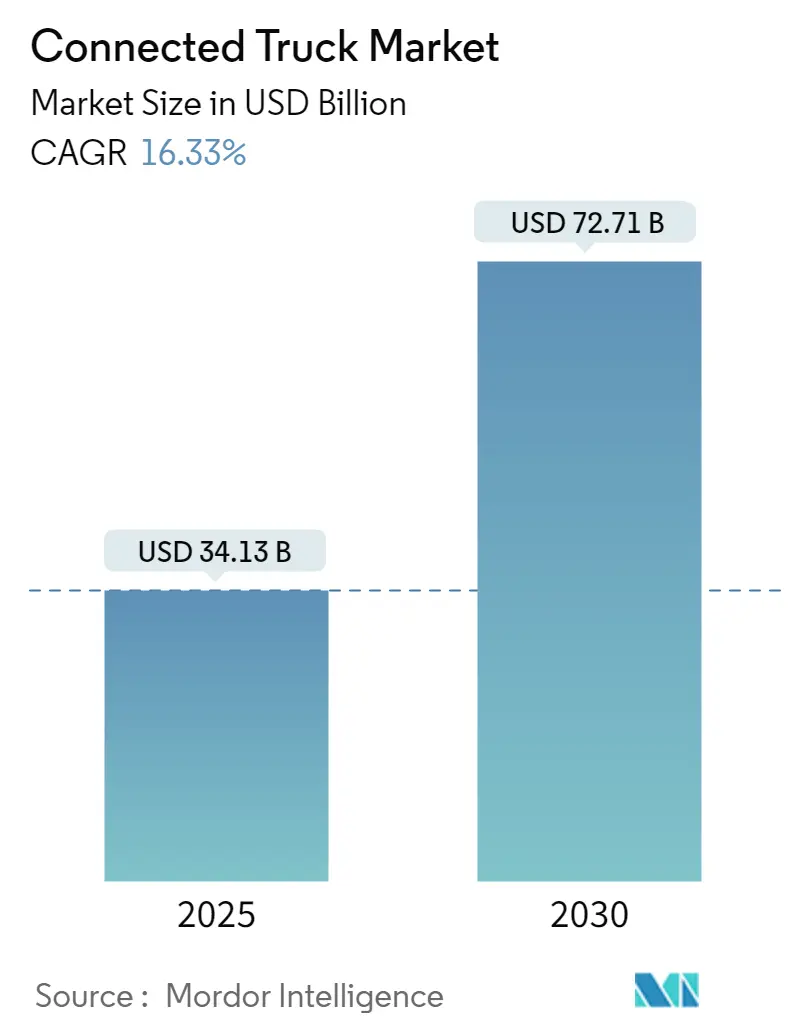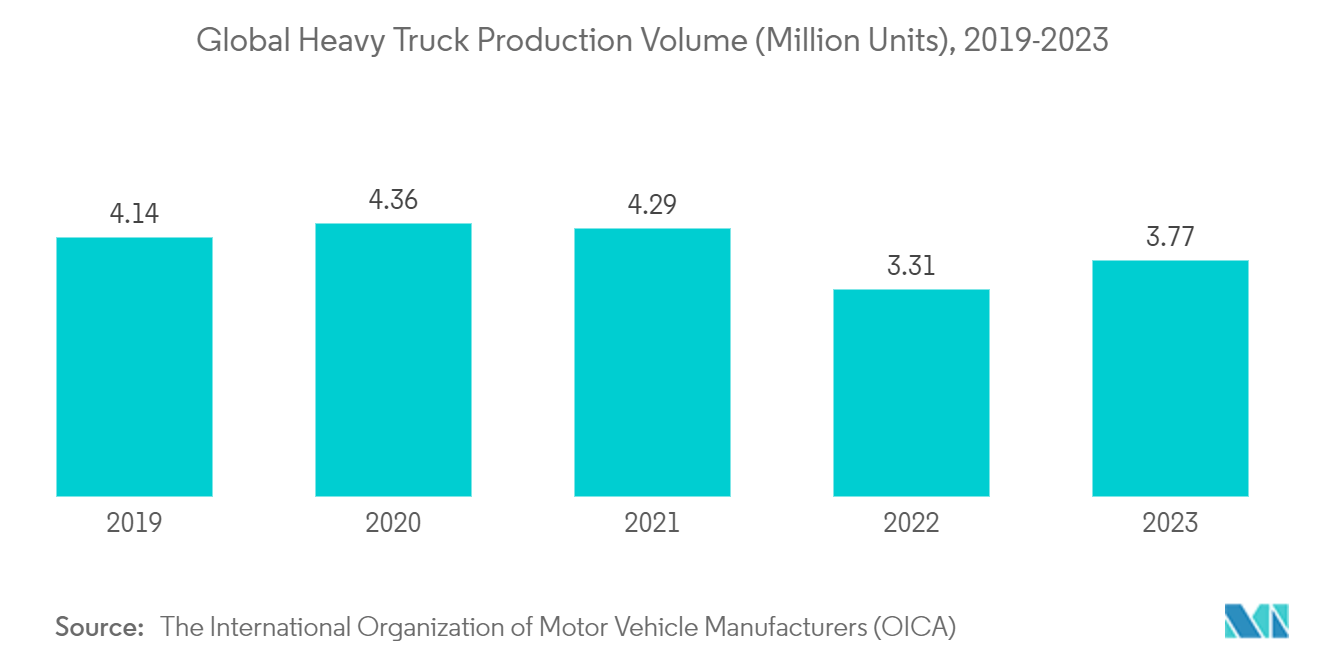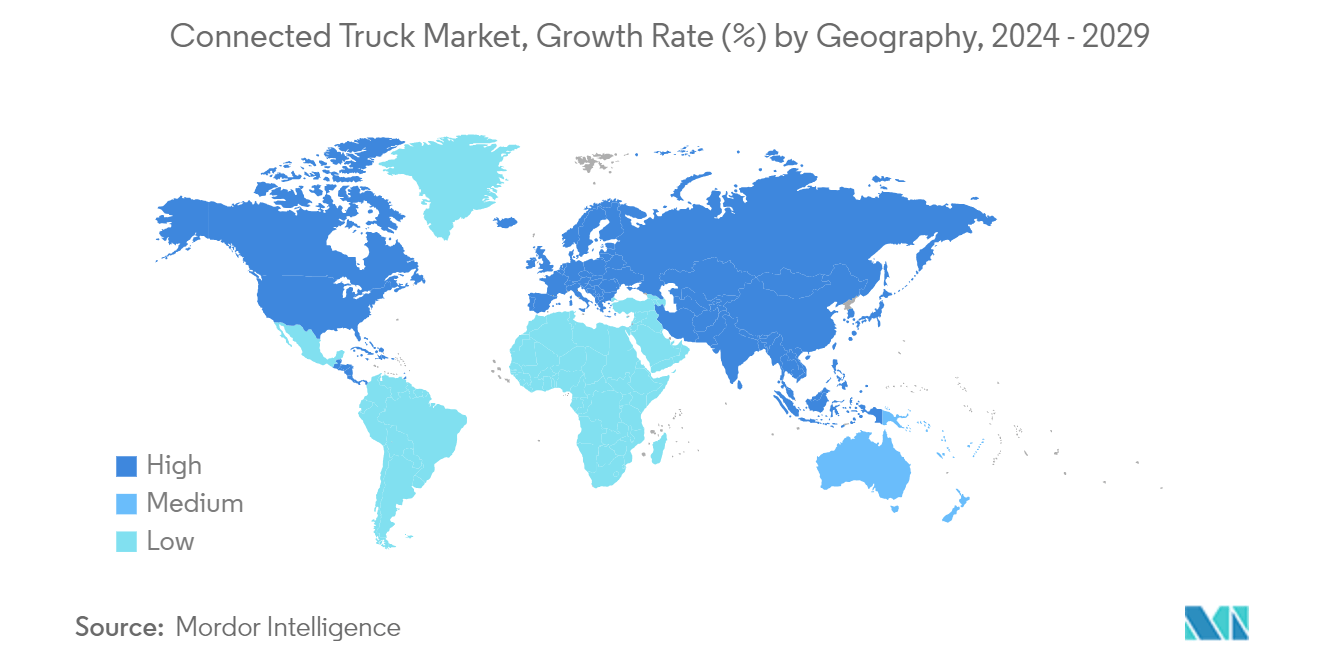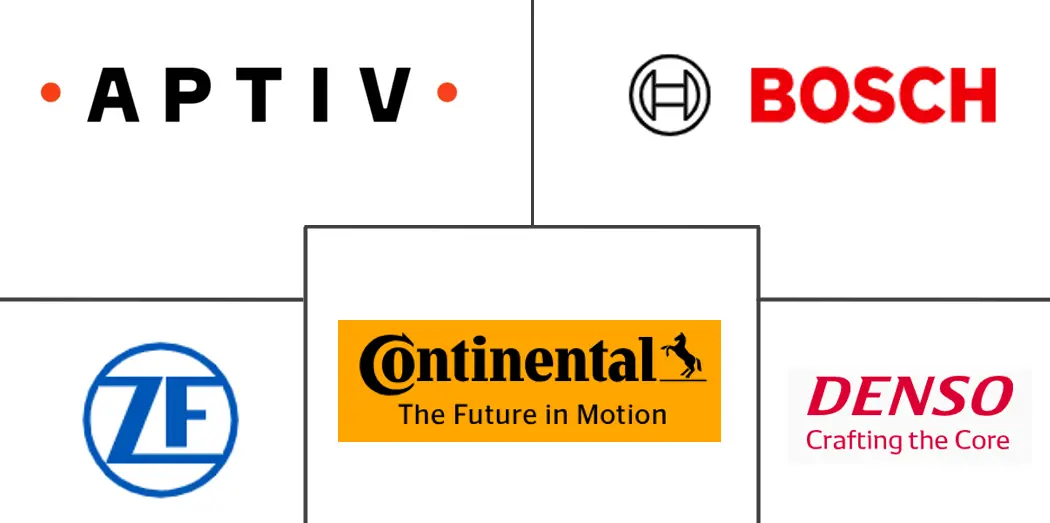Connected Truck Market Size and Share

Connected Truck Market Analysis by Mordor Intelligence
The Connected Truck Market size is estimated at USD 34.13 billion in 2025, and is expected to reach USD 72.71 billion by 2030, at a CAGR of 16.33% during the forecast period (2025-2030).
Over the medium term, the connected truck market is expected to grow rapidly, driven by the integration of advanced technologies into the transportation and logistics sector. There is increasing demand for telematics solutions, IoT-enabled connectivity, and data analytics applications in commercial vehicles. Key drivers of this growth include the need for improved fleet management efficiency, enhanced safety, and compliance with strict emissions and regulatory standards.
The rise of e-commerce and increasing industrialization are driving the demand for real-time tracking, remote diagnostics, and predictive maintenance in commercial vehicles. Fleet operators are adopting connected truck technologies to optimize routes, monitor driver behavior, and minimize downtime, thus improving overall operational efficiency.
Through connected truck technology, fleet operators anticipate optimizing factors such as fuel, maintenance, and driver wages, which contribute more than 60% of the total cost of ownership. More than 35 million trucks globally are expected to be connected within the next five years.
North America and Europe lead the connected truck market, while Asia-Pacific is gaining traction. Competition is intense, with major players focusing on collaborations, partnerships, and innovations to stay competitive.
Global Connected Truck Market Trends and Insights
Long Range (Telematics Control Unit) is Expected to Witness the Highest Growth
Telematics is incredibly important for creating innovative solutions that improve the effectiveness of supply chain logistics and fleet management. It offers real-time information and insights that help streamline operations, uphold product quality, extend shelf-life, and minimize losses and insurance liabilities throughout the supply chain.
Telematics plays an increasingly pivotal role in commercial logistics and supply chains, as it effectively tackles crucial challenges associated with safety and regulatory compliance, driver monitoring, insurance, and infrastructure.
Telematics solutions offer a range of integrated features designed to enhance fleet operations, including live traffic updates, intelligent routing and tracking, rapid roadside assistance for emergencies or breakdowns, automatic toll payments, and insurance telematics. These capabilities are essential for improving operational efficiency, reducing fuel costs, optimizing resources, and ensuring real-time connectivity.
The growing e-commerce industry and rising online shopping activities are majorly driving the demand for connected trucks. Many e-commerce companies have their own logistics operations and are investing in large fleets of connected trucks equipped with telematics control units. These units allow them to remotely monitor truck safety, fleet performance, fuel efficiency, and driver behavior and predict maintenance needs.
Businesses are investing substantial resources in enhancing telematics technology and incorporating telematics devices into their commercial vehicles. The increasing adoption of telematics and the significant fleet orders from e-commerce companies are projected to be key drivers of growth in the connected truck market in the coming years.

North America and Europe Hold Major Market Shares
Europe and North America are leading the way in the connected truck market due to the rapid growth of the automotive industry in these regions. The strong transportation infrastructures in both regions are laying the groundwork for integrating advanced connected technologies into trucking operations.
The well-established road networks and communication systems are enabling the smooth integration of telematics solutions, real-time tracking, and data-driven analytics in commercial vehicles.
Stringent regulatory environments in North America and Europe are significant drivers for the implementation of connected truck solutions. Safety, emissions, and fuel efficiency standards are key concerns addressed by regulations, leading to a growing demand for advanced technologies that facilitate real-time monitoring and compliance. For instance:
- In January 2024, trucks conducting drayage activities in California must be registered in the CARB (California Air Resources Board) Online System, per the Advanced Clean Fleets (ACF) regulation in North America.
The dominance of these regions is significantly influenced by industry collaboration. Major truck manufacturers, technology providers, and fleet management companies have formed strategic partnerships to accelerate the development and deployment of connected truck solutions. In addition, major telecom companies in North America are collaborating with leading connected truck companies to broaden their range of products and services.
The demand for connected trucks in Asia-Pacific is anticipated to grow rapidly over the next five years due to the region's burgeoning economies and increasing emphasis on smart transportation solutions. The Chinese government focuses on several advanced vehicle technologies, like ADAS features and electric mobility.
While North America and Europe currently lead the way, other regions, particularly Asia-Pacific, are expected to catch up with the growth pace during the forecast period.

Competitive Landscape
The connected truck market is dominated by several key players, such as Robert Bosch GmbH, Denso Corporation, and ZF. These players also engage in joint ventures, mergers and acquisitions, new product launches, and product developments to expand their brand portfolios and cement their market positions. For instance:
- In April 2024, Irdeto, a leading digital platform cybersecurity provider, collaborated with Ford Trucks to strengthen the cybersecurity protocols of its trucks and components in compliance with the most recent industry standards and regulations.
- In January 2024, Tata Motors announced its connection of over 500,000 commercial vehicles with Fleet Edge, its dedicated connected vehicle platform. The platform utilizes smart technologies to enhance vehicle uptime and improve road safety. It provides real-time actionable insights on vehicle status, health, location, and driver behavior for every connected vehicle.
- In February 2023, the UK government revealed that it earmarked a substantial sum of USD 97.4 million to support the development and implementation of commercial vehicle-connected vehicle technologies across the nation.
Connected Truck Industry Leaders
-
Robert Bosch GmbH
-
Aptiv PLC
-
Denso Corporation
-
ZF Friedrichshafen AG
-
Continental AG
- *Disclaimer: Major Players sorted in no particular order

Recent Industry Developments
- May 2024: Volvo Group and Daimler Truck collaborated to digitally transform heavy-duty commercial vehicles using software-defined technology. They are establishing a joint venture to create a unified software-defined vehicle platform and a specialized truck operating system for the next generation of commercial vehicles.
- May 2024: Isuzu Motors Limited collaborated with Gatik AI Inc. in California to advance the growth of autonomous driving technology in North America. As part of the collaboration, Isuzu is making a substantial investment of USD 30 million in Gatik. This investment aims to establish a robust partnership between the two companies as they work toward developing mobility services centered on level 4 autonomous driving technology.
- April 2024: DAF Trucks launched PACCAR Connect, an advanced online fleet management platform that offers convenient access and seamless integration with existing third-party software. With every new DAF XB, XD, XF, XG, and XG+ model, 10 years of PACCAR Connect is now a standard feature.
Global Connected Truck Market Report Scope
Connected trucks are equipped with several sensors and advanced technology, including an advanced driver assistance system, fleet management system, fuel management system, and vehicle maintenance system. These technologies assist in monitoring vehicle conditions and reducing commercial vehicle downtime.
The connected truck market is segmented by vehicle type, range, communication type, and geography. By vehicle type, the market is segmented into light commercial vehicles and heavy commercial vehicles. By range, the market is segmented into dedicated short-range communication (DSRC) and long range (telematics control unit). By dedicated short-range communication (DSRC), the market is further segmented into blind spot warning (BSW), forward collision warning (FCW), lane departure warning (LDW), emergency brake assist (EBA), and other dedicated short ranges. By communication type, the market is segmented into vehicle-to-vehicle (V2V), vehicle-to-cloud (V2C), and vehicle-to-infrastructure (V2I). By geography, the market is segmented into North America, Europe, Asia-Pacific, and Rest of the World. For each segment, the market sizing and forecast have been done based on value (USD).
| Light Commercial Vehicles |
| Heavy Commercial Vehicles |
| Dedicated Short-range Communication (DSRC) | Blind Spot Warning (BSW) |
| Forward Collision Warning (FCW) | |
| Lane Departure Warning (LDW) | |
| Emergency Brake Assist (EBA) | |
| Other Short Ranges | |
| Long Range (Telematics Control Unit) |
| Vehicle-to-Vehicle (V2V) |
| Vehicle-to-Cloud (V2C) |
| Vehicle-to-Infrastructure (V2I) |
| North America | United States |
| Canada | |
| Rest of North America | |
| Europe | Germany |
| United Kingdom | |
| France | |
| Italy | |
| Spain | |
| Rest of Europe | |
| Asia-Pacific | China |
| India | |
| Japan | |
| South Korea | |
| Rest of Asia-Pacific | |
| Rest of the World | South America |
| Middle East and Africa |
| By Vehicle Type | Light Commercial Vehicles | |
| Heavy Commercial Vehicles | ||
| By Range | Dedicated Short-range Communication (DSRC) | Blind Spot Warning (BSW) |
| Forward Collision Warning (FCW) | ||
| Lane Departure Warning (LDW) | ||
| Emergency Brake Assist (EBA) | ||
| Other Short Ranges | ||
| Long Range (Telematics Control Unit) | ||
| By Communication Type | Vehicle-to-Vehicle (V2V) | |
| Vehicle-to-Cloud (V2C) | ||
| Vehicle-to-Infrastructure (V2I) | ||
| By Geography | North America | United States |
| Canada | ||
| Rest of North America | ||
| Europe | Germany | |
| United Kingdom | ||
| France | ||
| Italy | ||
| Spain | ||
| Rest of Europe | ||
| Asia-Pacific | China | |
| India | ||
| Japan | ||
| South Korea | ||
| Rest of Asia-Pacific | ||
| Rest of the World | South America | |
| Middle East and Africa | ||
Key Questions Answered in the Report
How big is the Connected Truck Market?
The Connected Truck Market size is expected to reach USD 34.13 billion in 2025 and grow at a CAGR of 16.33% to reach USD 72.71 billion by 2030.
What is the current Connected Truck Market size?
In 2025, the Connected Truck Market size is expected to reach USD 34.13 billion.
Who are the key players in Connected Truck Market?
Robert Bosch GmbH, Aptiv PLC, Denso Corporation, ZF Friedrichshafen AG and Continental AG are the major companies operating in the Connected Truck Market.
Which is the fastest growing region in Connected Truck Market?
Europe is estimated to grow at the highest CAGR over the forecast period (2025-2030).
Which region has the biggest share in Connected Truck Market?
In 2025, the North America accounts for the largest market share in Connected Truck Market.
What years does this Connected Truck Market cover, and what was the market size in 2024?
In 2024, the Connected Truck Market size was estimated at USD 28.56 billion. The report covers the Connected Truck Market historical market size for years: 2019, 2020, 2021, 2022, 2023 and 2024. The report also forecasts the Connected Truck Market size for years: 2025, 2026, 2027, 2028, 2029 and 2030.
Page last updated on:
Connected Truck Market Report
Statistics for the 2025 Connected Truck market share, size and revenue growth rate, created by Mordor Intelligence™ Industry Reports. Connected Truck analysis includes a market forecast outlook for 2025 to 2030 and historical overview. Get a sample of this industry analysis as a free report PDF download.



